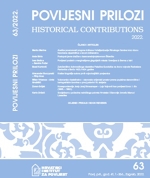Public Auction Procedure in Late Medieval Šibenik
DOI:
https://doi.org/10.22586/pp.v41i63.23932Keywords:
Šibenik, statutarno pravo, javna držaba, 15. stoljećeAbstract
Among the various provisions related to certain segments of property law in most of the statutes of medieval Dalmatian communes, due attention was paid to the mode of acquisition. Buying at a public auction (emptio ad publicum incantum) is mentioned as one of these modes in all Dalmatian statutes, more or less extensively.
This paper focuses primarily on the statutory provisions in the Book of Statutes, Laws, and Reforms of the City of Šibenik, which regulated various aspects related to the public auction procedure, starting with who had the right to participate in a public auction, the procedure, the regulation of cases when property could not be sold at a public auction (if damage was caused to the owner), and the issue of sanctioning those who would not pay the agreed price or would sell stolen property at an auction. What the application of these statutory provisions looked like in practice and whether they became “a petrified, dead letter on paper” or a “living source by which legal reality was shaped” (Nella Lonza) can be inferred from the breviary of public auctions kept in the preserved records of Šibenik notaries from the 15th century. It reveals details related to the identity of buyers, the value of items sold at the auctions, their origin and possible further (re)sale. This allows for a more complete insight into the various aspects of public auction institutes – their particularities, similarities, and differences – both at the local level of the city and at the regional (Dalmatian) level.
Downloads
Published
How to Cite
Issue
Section
License
Copyright (c) 2022 Authors and journal

This work is licensed under a Creative Commons Attribution-NonCommercial 4.0 International License.







